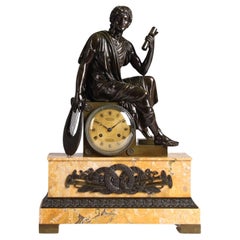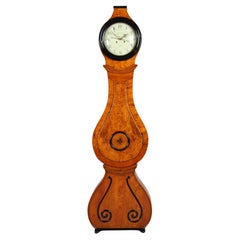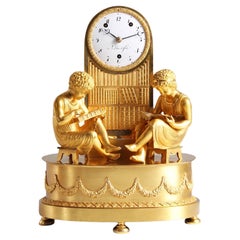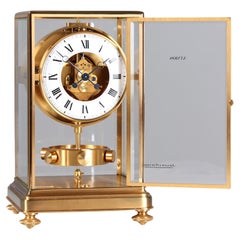Video Loading
Want more images or videos?
Request additional images or videos from the seller
1 of 17
Writing Set with Desk Clock, Carriage, Pendulette, Paris, Signed Moser, C. 1850
$5,346.20List Price
About the Item
- Dimensions:Height: 9.06 in (23 cm)Width: 15.36 in (39 cm)Depth: 7.88 in (20 cm)
- Materials and Techniques:
- Place of Origin:
- Period:
- Date of Manufacture:1850
- Condition:Wear consistent with age and use. Very good and restored condition. Rubbing of the gilding on the porcelain. Overhauled and clean running movement.
- Seller Location:Greven, DE
- Reference Number:1stDibs: LU5419231200382
About the Seller
5.0
Platinum Seller
Premium sellers with a 4.7+ rating and 24-hour response times
Established in 2014
1stDibs seller since 2020
207 sales on 1stDibs
Typical response time: 1 hour
Authenticity Guarantee
In the unlikely event there’s an issue with an item’s authenticity, contact us within 1 year for a full refund. DetailsMoney-Back Guarantee
If your item is not as described, is damaged in transit, or does not arrive, contact us within 7 days for a full refund. Details24-Hour Cancellation
You have a 24-hour grace period in which to reconsider your purchase, with no questions asked.Vetted Professional Sellers
Our world-class sellers must adhere to strict standards for service and quality, maintaining the integrity of our listings.Price-Match Guarantee
If you find that a seller listed the same item for a lower price elsewhere, we’ll match it.Trusted Global Delivery
Our best-in-class carrier network provides specialized shipping options worldwide, including custom delivery.You May Also Like
R&C Paris Brass Carriage Clock, c. 1900's
Located in Los Angeles, CA
Beautiful brass carriage clock made by R&C Paris having decorated foliate scrolls all around the piece and standing on four winged beast figure feet, also having enamel dial with bla...
Category
Antique Early 1900s French Carriage Clocks and Travel Clocks
Materials
Brass
LeCoultre Pendulette Chinoise 8 Day Desk Clock, Asian Woman and Botanical
By Jaeger-LeCoultre
Located in Toledo, OH
LeCoultre Pendulette Chinoises 8 day desk clock, Asian woman and botanical. Circa 1960s. Beautiful LeCoultre desk clock details. Acrylic with a black ...
Category
Mid-20th Century Table Clocks and Desk Clocks
Materials
Acrylic
$3,500
H 6.25 in W 8.63 in D 2.25 in
American Brass Miniature Carriage Clock with Beveled Glass, New York. C. 1850
By James Mix
Located in Charleston, SC
American brass miniature carriage clock with beveled glass, carrying handle , and signed enamel over copper face with dial. Clock consists of time, strike,...
Category
Antique 1850s American American Classical Clocks
Materials
Brass, Copper, Enamel
$5,000
H 4.75 in W 3.5 in D 3.5 in
French Bronze Carriage Clock by Jules, Paris, c. 1840
Located in Los Angeles, CA
Graceful bronze carriage clock by Jules, Paris, c. 1840 (Late 19th Century), numbered 542 and includes "Jules A Paris" stamp as well. The piece is finely decorated with foliate engra...
Category
Antique 1840s French Carriage Clocks and Travel Clocks
Materials
Bronze
Baccarat Crystal Hypnos Pendulette Table Clock, France
By Baccarat
Located in Los Angeles, CA
This stunning 20th Century "Hypnos" table clock by France's renowned Baccarat company has quartz movement, a glass case, a white dial, and black Arabic numerals. The clock has a few ...
Category
20th Century French Modern Table Clocks and Desk Clocks
Materials
Crystal, Quartz
French Carriage Clock
Located in San Francisco, CA
C. 20th century Adorable French Carriage clock w/ original case & personal provenance.
Brass Case in a classic corniche style, Beveled glass panels & ...
Category
20th Century Carriage Clocks and Travel Clocks
Materials
Brass, Enamel
Victorian French Carriage Clock with Compass
Located in Norwich, GB
Victorian oval shaped carriage clock in a ‘patinated’ case standing on a raised circular base.
Enamel dial with Roman numerals and original ‘blued’ steel hands.
Eight day French movement with platform escapement. A compass is mounted on the top with bevelled glass, silvered dial and locking lever.
Not only is it very rare to find oval carriage clocks...
Category
Antique 19th Century French Victorian Carriage Clocks and Travel Clocks
Materials
Brass
Repeating Drocourt Carriage Clock with Alarm
Located in Amersham, GB
A strike repeat alarm carriage clock by Pierre Drocourt. Stamped and numbered with the Drocourt mark on the back plate in a gilded 'Gorge' case. Drocourt was one of the great carriag...
Category
Antique 1860s French Victorian Carriage Clocks and Travel Clocks
Materials
Brass, Steel, Ormolu
Victorian Carriage Clock signed Hampton & Sons, Pall Mall
Located in Norwich, GB
Victorian striking carriage clock, Hampton & Sons, Pall Mall
Victorian carriage clock in a fine variegated green onyx case standing on a rai...
Category
Antique 19th Century French Victorian Carriage Clocks and Travel Clocks
Materials
Onyx
Signed Bronze Pierre-Philippe Thomire of Paris Clock Putti Cherub Clock Set
By Pierre-Philippe Thomire
Located in Swedesboro, NJ
Presenting a spectacular early 19th-century French three-piece bronze doré clock set signed by Thomire of Paris, a breathtaking ensemble that epitomizes the luxury, craftsmanship, an...
Category
Antique 1830s French Empire Mantel Clocks
Materials
Bronze
$19,373
H 24 in W 7 in D 7.5 in
More From This Seller
View All1830s French Table Clock, signed by LESIEUR á Paris, Pendule "Virgil the Poet"
By Lesieur
Located in Greven, DE
Pendule - Virgil the Poet
Paris
Bronze, marble
around 1830
Dimensions: H x W x D: 61 x 43 x 17 cm
Description:
Large and, at around 30 kg, very heavy French bronze clock from the ...
Category
Antique 1830s French Restauration Table Clocks and Desk Clocks
Materials
Siena Marble, Bronze
Mid 19th Century Swedish Mora Longcase Clock With Date Display, Circa 1850
Located in Greven, DE
Antique Mora grandfather clock made from solid birch
Sweden
Birch tree
Mid 19th century
Dimensions: H × W × D: 208 × 54 × 19 cm
Description:
Antique grandfather clock in typical S...
Category
Antique Mid-19th Century Swedish Grandfather Clocks and Longcase Clocks
Materials
Birch
Empire Mantel Clock - La Bibliotheque, Ormolu, France, Paris, circa 1820
By Le Roi
Located in Greven, DE
Mantel Clock - La Bibliotheque - In the study room
Paris
fire-gilt bronze, enamel
Empire around 1820
Dimensions: H x W x D: 38 x 28 x 19 cm
Description:
Scenery mounted on an oval...
Category
Antique Early 19th Century French Empire Mantel Clocks
Materials
Bronze
Jaeger LeCoultre, Desk Clock, Atmos Prestige, Limited Edition, 1980s
By Jaeger-LeCoultre
Located in Greven, DE
Atmos Clock - "Prestige" by Jaeger LeCoultre with original box
Switzerland
Gold-plated brass
1980s
Dimensions: H x W x D: 27 x 17 x 16 cm
Description:
The Atmos Prestige from Jaeg...
Category
Vintage 1980s Swiss Modern Table Clocks and Desk Clocks
Materials
Brass
French Empire Ormulu Bronze Mantel Clock, Lepaute, Thomire, Paris, circa 1815
Located in Greven, DE
Ormulu pendule with depiction of friendship and love
Paris (Lepaute, Thomire)
fire-gilt bronze
Empire around 1815
Dimensions: H x W x D: 44 x 36 x 13 cm
French pendulum movement with eight days duration. Thread suspension and lock disc striking movement with strike on bell on the half and full hour.
White enamel dial with Roman hour numerals and Breguet hands.
Signature: LePaute & Fils / Hrl. du Roi (Pierre-Basile Lepaute (1750 - 1843) with his son Pierre-Michel Lepaute (1785-1849); from 1811 in joint workshop).
Description:
The extremely high quality pendulum shown here takes up a profound theme: Friendship, which combines with love and can thereby outlast time and death. As it is typical for the epoch of classicism, personifications and symbols are taken from the fund of ancient mythology and art and then developed further.
The main figure is a young woman in an antique, girded garment, standing barefoot and with crossed legs next to an altar, on which she is leaning with her left elbow. She gracefully bows her head towards a tempestuously approaching Cupid, grasps his right hand with her left and draws him to her bosom, the seat of the heart. The delicate ambivalence of flying towards and being held culminates in the trustingly intimate look that the two cast at each other.
The young woman personifies friendship, the winged Cupid love. As a sign of their intimate connection, two burning hearts appear on the altar next to the two, framed by the puffed scarf, which are closely bound together by a chain of flowers.
Next to them, on the altar slab, one can see an erected book with the title "Amitie" (French: amitie, friendship). Supporting the book is a pomegranate held by a ring of pomegranate flowers. The bursting seeds spill out of the cracked skin. Since ancient times, the pomegranate and its blossoms have been dedicated to the goddess Persephone, symbolizing the underworld and death, but also life and fertility. The myrtle interwoven in the pomegranate flower wreath of "friendship" also has a far-reaching symbolic power: the plant was dedicated to the goddess Aphrodite, stands for virginity, and was and is therefore obligatory in the bridal wreath...
Category
Antique Early 19th Century French Empire Mantel Clocks
Materials
Bronze, Enamel
Early 19th Century Ormolu Mantel Clock, Atala freeing Chactas, Paris, circa 1810
Located in Greven, DE
Mantel Clock "Atala and Chactas"
Paris
Bronze (fire-gilt and patinated), enamel
Empire around 1810
Dimensions: H x W x D: 40 x 32 x 11 cm
Description:
Very rare and extremely high quality French mantel clock, so-called Pendule Au Bon Sauvage.
Depicted are scenes from the love story "Atala or the love of two savages in the desert" written by Francois René Vicomte de Chateaubriand in 1801. At the beginning of the 19th century, this was probably the most famous love story in Europe, but today it has been forgotten.
The story, set in present-day Louisiana (USA), is roughly rewritten about the forbidden love between Chactas, a young Indian, and Atala, the beautiful daughter of a Spaniard.
Chactas is captured in a battle between two Indian tribes, chained to a palm tree and is to be sacrificed. Atala wants to save his life and convert him to Christianity. She unties him from the palm tree at night and they flee together into the wilderness of North America. Their love for each other grows stronger and stronger and they have prospects for a future together.
The story takes a tragic turn when Atala, who must remain a virgin due to a vow made by her mother, can no longer withstand the conflict of her feelings and commits suicide.
The main group of characters thus shows Chacta's liberation through Atala. Atala is leaning against a pile of logs. The animal fur thrown over the logs and the weapons leaning against the stack on the right give the impression of a night camp.
The bronze is of rarely beautiful quality, finely chiselled and makes the scene appear very lively. The contrast of fire-gilded and patinated bronze adds tension to the composition.
In the base we see the Entombment as the end of the tragic love story. This bronze work is also very detailed, the interplay of bright and matt gilding makes the flat relief appear much deeper than it is.
The depiction of the mantel clock presented here shows that the exotic was only known from stories and that the bronzier had his own ideas about the appearance of this distant world. The Indian, for example, has very European facial features and his skin was not black in reality, of course. The palm tree was also certainly not found in the North American wilderness.
The heart of the clock is a French pendulum movement, integrated into the wooden pile, with an eight-day power reserve and a lock plate striking a bell on the half and full hour. The pendulum is suspended on a thread, typical of the period. The classically shaped hands, so-called Breguet hands, are also typical of the time.
The enamelled dial has black Roman hour numerals, Arabic quarter hours and bears the signature: Le Roy hr. de Madame A PARIS.
Interesting facts:
The period from 1795 to about 1815 saw the creation of probably the most spectacular group of bronzes: The "Au bon Sauvage" pendulums - depictions of the "Noble Savage".
Today's viewers react to these objects with both fascination and irritation. Enthusiastic on the one hand about the obvious quality of the detailed bronzes and the allure of the exotic, on the other hand distanced and cautious because of the possible discrimination that is suspected behind them. The ambivalence of this feeling motivates the search for the conditions of origin of these pendulums.
Europeans found their new ideal of the natural man primarily in fictional and realistic travelogues about the Indians of North America...
Category
Antique Early 19th Century French Empire Mantel Clocks
Materials
Ormolu
Recently Viewed
View AllMore Ways To Browse
Paris Writing Desk
Moser Glass Set
Brass Clock Set
Signed Moser
Antique Travel Inkwell
Travelling Inkwell
Paris Clock Set
Brass Carriage Clock Made In France
Moser Desk
Inkwells With Clock
Writing Desk With Clock
Golden Clock
Kienzle Vintage Clock
Brass Alarm Clocks
Desk Travel Clock
Vintage Crystal Clock
Vintage Lucite Clock
Tiffany And Co Desk Clock



